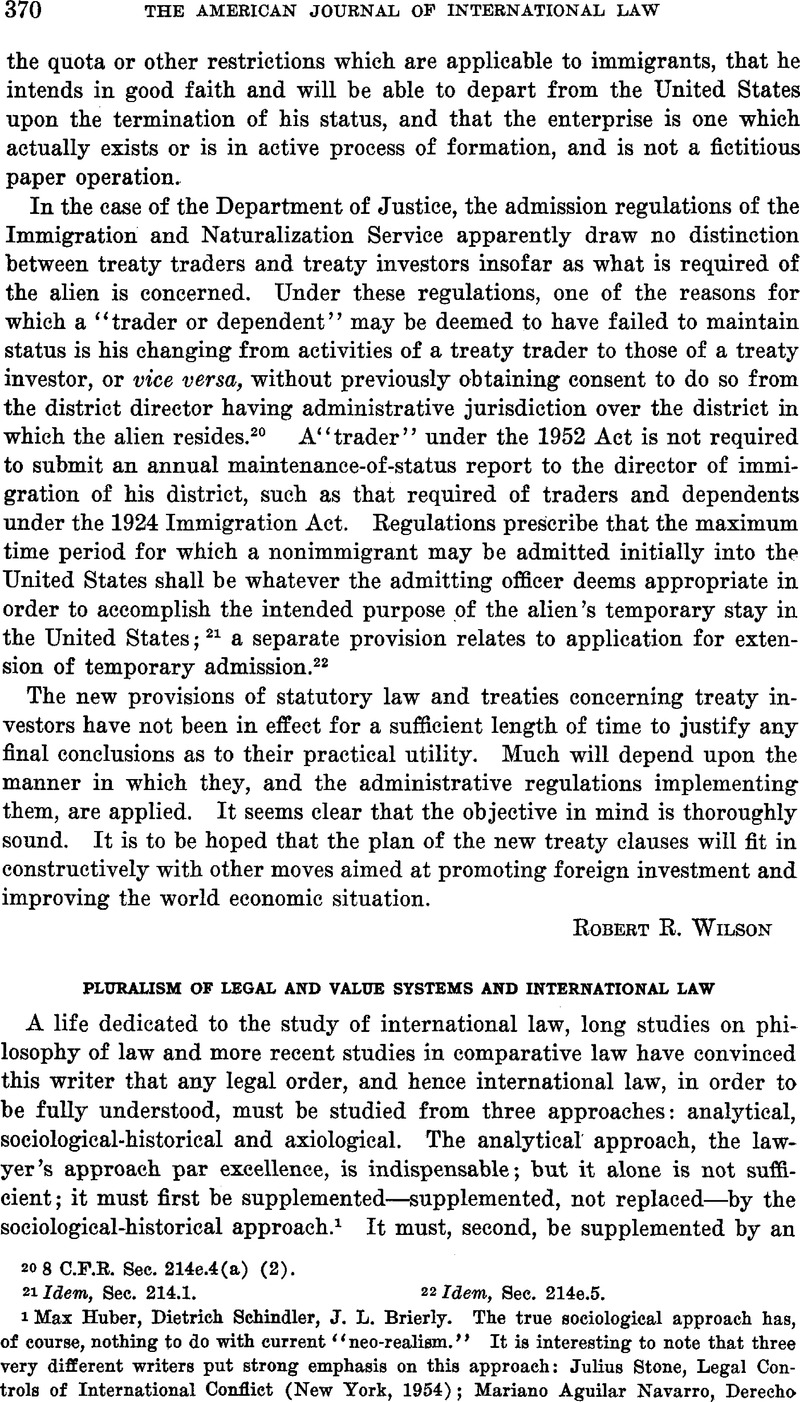Published online by Cambridge University Press: 30 March 2017

1 Max Huber, Dietrich Schindler, J. L. Brierly. The true sociological approach has, of course, nothing to do with current “neo-realism.” It is interesting to note that three very different writers put strong emphasis on this approach: Julius Stone, Legal Controls of International Conflict (New York, 1954); Mariano Aguilar Navarro, Derecho International Público (3 vols. Madrid, 1952–1954); and De Visscher, Charles, Théories et Réalités en Droit International Public (Paris, 1953)Google Scholar. See also Schiffer, Walter, The Legal Community of Mankind (New York, 1954)Google Scholar.
2 It is, of course, necessary to recognize that “natural law,” so called, is not law, but ethics, a system of norms superior to law, by which to judge a legal order not as law or non-law, but as good or bad law. In this sense modern adherents of natural law: the German Coing, the Spaniard Legaz y Lacambra, the Mexican Rafael Preciado Hernández. The Belgian Jean Dabin, an orthodox Neo-Thomist, now states unequivocally “Au binôme: droit naturel-droit positif il faut substituer celui de: moraledroit.” Théorie Générale du Droit (Brussels, 1953).
3 Up to the beginning of the nineteenth century writers spoke of the “Droit des Gens de l’Europe.” Still in 1856 Turkey was admitted “to participate in the advantages of the Public Law and System of Europe.”
4 All other countries were referred to as “pays hors chrétienté.”
5 “Existent international law is the creation of but one historical portion of one living culture” (italics supplied). Northrop “Contemporary Jurisprudence and International Law,” 61 Yale L. J. 636 (1952)Google Scholar.
6 See the Russian scholar, de Taube, Baron, “Études sur le développement historique du Droit International dans 1’Europe Orientale” 11 Hague Academy of International Law, Recueil des Cours 345–535 (1926)Google Scholar, and “L’apport de Byzance au développement du droit international occidental” 67 Ibid. 237–339 (1939)Google Scholar. A modern Greek writer has seen the principal reason for the many Balkan crises of the nineteenth and twentieth centuries in the “total lack of understanding which the men of Occidental Europe have shown toward the states of Byzantine origin.” Papaligouras, P. A., Théiorie de la Société Internationale 489 (Zurich, 1941)Google Scholar.
7 See Aguilar Navarro, op. cit. supra, note 1, and de Luna, Antonio, “Fundamentación del Derecho International,” 60 Revista de Dereeho Internacional 210–264 (Havana, 1952)Google Scholar.
8 “Humanum genus, quamvis in varios populos et regna divisum, semper habet aliquam unitatem non solum specificam, sed etiam quasi politicam et moralem.” Francisco Suárez, De legibus ae Deo legislatore.
9 Thus Lauterpacht wrote some time ago that there is danger that states of the common law may be outvoted at international conferences, that international tribunals are mostly manned by Roman-law lawyers who have little (if any) knowledge of the common law, and that there is little justification today to make the development of international law exclusively dependent on Roman and civil law or to attribute to one system of law of a particular time and space the qualities of a universal law. Private Law Sources and Analogies in International Law 178.
10 It remained for the leading National Socialist lawyer, Carl Schmitt, to attack what he called the “dissolution” of European order in a vague and universal, so-called “international law.” “Die Auflösung der europäischen Ordnung im International Law,” 5 Deutsche Rechtswissenschaft 267–278 (1940)Google Scholar; against him Wehberg, H., in 41 Die Friedenswarte 157–166 (1941)Google Scholar.
11 See the interesting account in “Japan’s Reception of the Law of Nations,” by Professor Ohira, Zengo, 4 Annals of the Hitotsubashi Academy (Tokyo) 55–66 (1953)Google Scholar.
12 Arnold Toynbee warned even in 1934 against the “misconception of the unity of culture.” 1 A Study of History 149 ff. (1934)Google Scholar.
13 “Soviet law is a completely unique type of law; it is not a further development of bourgeois law, but a new type of law.” A. Golumakii and M. S. Strogovitch, quoted in “Soviet Legal Philosophy,” 5 XXth Century Legal Philosophies Series 385–386 (Cambridge, Mass., 1951).
14 48 A.J.I.L. 98–103 (1954).
15 Kurt Wilk in 45 Ibid. 648–670 (1951).
16 Thus, E. Korovine, Das Völkerrecht der Übergangszeit (1929. German tr. from Russian original of 1924).
17 See Taracouzio, The Soviet Union and International Law (1935); Krylov, S., “La doctrine soviétique du droit international,” 70 Hague Academy of International Law, Recueil des Cours 411–471 (1947)Google Scholar.
18 For a broader treatment, see Kunz, Josef L., “Pluralismus de Naturrechte und Völkerrecht,” 6 Österreichisehe Zeitschrift für Öffentliches Recht 185–220 (1954)Google Scholar.
19 See this writer’s editorial in 48 A.J.I.L. 103–110 (1954).
20 Moslem law has been studied, as far as the West is concerned, in England and France; see Milliot, Louis, Introduction à l’étude du droit musulman (Paris, 1953)Google Scholar. Recently it has also attracted attention in the United States; see Symposium on Moslem Law in 22 Geo. “Wash. L. Rev. 1–39, and 127–186 (1953). In September, 1953, a Conference on Islamic Culture was held at Princeton University.
21 See Schnitzer, F. A., Vergleichende Rechtswissenschaft 260–267 (Basle, 1945)Google Scholar; David, René, Traité Elémentaire de Droit Comparé 377–393 (Paris, 1950)Google Scholar. See also Jean Escarra, Le Droit Chinois.
22 See his books: The Meeting of East and West (New York, 1947); Editor: Ideological Differences and World Order (New Haven, 1949); id., The Taming of the Nations (New York, 1952), and his article, loc. cit. supra, note 5.